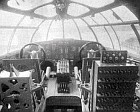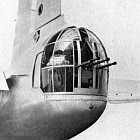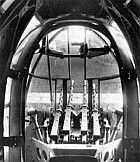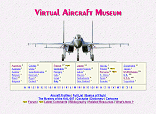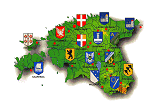Aircraft Profile #189. Short Sunderland |
|
|
The Short Sunderland first flew in 1937. Today, thirty years later, passenger conversions are still flying in some parts of the world. It entered service with the Royal Air Force in 1938 as a reconnaissance aircraft with Coastal Command and was only retired from this task in 1958 - twenty-one years service in the same role, a record for any R.A.F. machine. Until quite recently it was performing exactly the same duties with the Royal New Zealand Air Force. Whichever way you look at it, the Sunderland was quite an aeroplane. It has usually been described as a straightforward development of the Empire Class flying boats which Short Brothers built for Imperial Airways before the war, but this is not strictly correct. Specification R.2/33 was issued in November 1933, after the R.A.F. had taken delivery of the huge six-engined Sarafand flying boat also built by Shorts. It called for a long-range, general purpose flying boat with a performance equal to that of the Sarafand but more compact in size and with four engines instead of six. The new aircraft could be either monoplane or biplane. Shorts, which at that time was headed by Oswald Short with Arthur Gouge as his chief designer, was still in the early deliberation stage of the new R.A.F. flying boat when Imperial Airways issued their somewhat pressing request for the Empire Boats which were to be based on the four-engined Scion Senior which served as a half-scale flying prototype. At this time there was still no firm decision on the general geometry of the R.2/33 machine. It was not Work on the prototype, K4774, commenced under contract No. 351564/34 on a design known at the time only as the S.25. A similar contract had been awarded to the Saunders-Roe A.33 which had been designed to the same specification. This aircraft eventually met with an accident and left the S.25 as the sole contestant. Shorts' new flying boat looked very similar to the Empire Boats which were rapidly nearing completion, but made much more use of extrusions, some of which were not ready in time for the civil flying boats, and had an improved shape to the planing bottom with the rear step tapered to a vertical knife edge to reduce aerodynamic drag. Proof that Shorts basic ideas were right came in June when Canopus the first of the Empire Class boats made a successful maiden flight. The Air Ministry's faith in Shorts was, however, displayed three months earlier when a development contract was placed for eleven more S.25 boats to specification 22/36. The
PROTOTYPE AIRCRAFT K4774 was completed by October, 1937, and by this time named Sunderland, emerged from Shorts No. 3 Shop at Rochester to be launched on the 14th of that month. The 1,010hp Pegasus XXII engines which were to power the aircraft were not yet available and K4774 commenced her initial taxiing and flight trials with Pegasus X's of 950hp each. The first flight with John Lankester Parker at the controls and Harold Piper as co-pilot
The R.A.F.'s
The wings were of all-metal cantilever box construction, generally similar to those of the Empire Boats and using a main spar formed by two pairs of tapering “T” section extrusions braced vertically and diagonally with tubes to form a front and rear truss. Both wings and flaps were covered with sheet metal but only the leading edge portion of the Frise-type ailerons employed metal skins and the trailing edge portion was fabric covered. The engine nacelles were built into the leading edge of the wing and were of circular monocoque construction. Accessibility to the engines was good and was either through the removable cowling or through doors in the fireproof bulkhead. The all-metal
Tailplane and fin construction closely followed that of the wings and, again the moving surfaces were largely fabric covered. Both horizontal and vertical tail surfaces were attached to stub sections on the rear hull by bolts in expanding bushes - a method which made removal a simple and speedy operation. The main dissimilarity between the Sunderland and the Empire Class boats was in the hull with the R.A.F. aircraft having a deeper forefoot, tapered rear step and the flight deck set back to accommodate the retractable bow turret. The Sunderland hull was constructed mainly of aluminium-coated light alloy which was anodically treated before riveting into position. The skeleton framework consisted of channel section vertical frames interconnected by longitudinal intercostal "Z" section stiffeners, one of which would form the main floor bearer. The main step of the planing bottom was shaped to a broad "V" in plan view and the rear step faired into a vertical knife edge. The centre keelson was continuous and all stiffeners terminated at the frames which were slotted to fit over the keelson. Countersunk rivets were used on exterior surfaces. The main spar frames were
A double deck layout was employed in the forward fuselage with the entrance door and wardroom situated below the flight deck. Forward of the wardroom was the mooring compartment on a raised deck. This contained the anchor and its winch, a mooring ladder and a "J" type dinghy. It also housed the bomb sight and forward-hingeing bomb-aimer's window above which was the front turret. The flight deck was reached either by a companion way adjacent to the forward entrance door or via a ladder in the galley just aft of the wardroom. There was accommodation for two pilots, an engineer and a navigator/radio operator. Each pilot had a wheel-type control column with the top section hinged so that it could be lowered to improve instrument visibility. The instrumentation for pilots on early Sunderlands was somewhat basic, comprising ASI, altimeter gyro-compass and gyro-horizon, rate of climb indicator and turn and bank. The engines were represented with boost gauges and r.p.m. indicators. Trim controls were situated in the roof between the two pilots and the aircraft carried a Mark IV 3-axes autopilot. The galley, which was on the lower deck just aft of the wardroom carried drogue stowage compartments and the trailing aerial in addition to the type of culinary equipment which was to be expected. The crew quarters were at the aft end of the lower deck next to the galley and contained two bunks and a table in the forward of the two compartments and two bunks in the other. Aft of this again was a catwalk to the rear turret. On
IN SERVICE At the start of World War Two there were three Squadrons operational with Sunderlands, all in home waters. These were Nos. 210, 204 and 228 Squadrons. The first Sunderland operation began at 05.00 hours on 3rd September 1939, the first day of the war. Flight Lieutenant Ainslie and his crew took off in L2J65 of No. 210 Squadron based at Pembroke Dock to patrol the shipping routes into Milford Haven. It was an uneventful, cold and cheerless trip - the prototype for the majority of flights which were later to be made by hundreds of Sunderland aircraft. A little more excitement came the following day when Flight Lieutenant R. P. A. Harrison and Sunderland L5579 of No. 210 Squadron were erroneously fired on by British anti-aircraft guns while returning from a patrol. Luckily the gunner's shooting matched their ability in aircraft recognition. The same Squadron gained the honour of making the first aerial attack against a U-boat on 8th September when Flight Lieutenant E. L. Hyde and his crew in N9021 sighted a periscope feather south-west of Lizard Head. Hyde attacked this submarine and another which he sighted soon afterwards but the eight bombs he dropped produced no dramatic effects. The honour of first making the headlines fell to No. 228 Squadron on 18th September when three of their aircraft received an SOS call from the tramp steamer Kensington Court which had
FURTHER DEVELOPMENT Meanwhile production and development continued at Shorts' Rochester factory although Sunderlands were ordered only in comparatively small batches. A second production line was set up by Blackburns and Denny Brothers at Dumbarton on the Clyde. A total of 75 Sunderland I's were built by Shorts and a further 15 by Blackburns when an improvement in performance was made by replacing the Pegasus XXIIs with Pegasus XVIIIs with two-speed superchargers. At the same time a two-gun Botha-type F.N.7 turret replaced the two open K-gun mountings and the F.N.13 tail turrets
U-BOAT KILLERS During the first few months of the war attacks on U-boats by Sunderlands had given only inconclusive and disappointing results. The 110kg and 220kg bombs with which the aircraft were armed were by no means perfect anti-submarine weapons and there was no depth charge suitable for carriage in the Sunderland. Nevertheless results were eventually achieved. On the last day of January 1940 Sunderland 'Y' of No.228 Squadron bombed U-55 which had been already damaged by Naval depth charges. Rather than risk further damage the Captain scuttled the U-boat. The honour of making the first complete kill, however, went to a Sunderland of No.10 (R.A.A.F.) Squadron on 17th July 1940. The exhilaration of making a kill is typified in the following report by Flying Officer E. R. Baker. On 16th August he was Captain of Sunderland P9624 on convoy escort duty when his co-pilot, Pilot Officer Bowie, sighted a submarine three hundred yards away on their port side. It was already partly submerged, ran Baker's subsequent report, and when we had got over the spot it had completely submerged but I let off a salvo of bombs which went off just underneath the U-boat. It was terrific. The surface of the sea seemed to shudder for yards around and then blew up. In the middle of the foam was the submarine. It was tilted over and its decks awash. It sank again The submarine was blown to the surface again, but this time it came so far up that I could pretty nearly see daylight between it and the sea. It came up on an even keel then turned over on its side and sank. Just to make sure I dropped a third salvo and this time there were huge bubbles of air and masses of oil. But the Sunderland had other adversaries besides enemy submarines. On more than one occasion it tangled with enemy aircraft and usually gave a good account of itself. The first air action in which a Sunderland was involved was on 3rd April 1940 when Flight Lieutenant Frank Phillips on convoy patrol in the North Sea, was attacked by six Ju 88's which had obviously decided to down the Sunderland first and then attack the convoy at leisure. The Sunderland was, of course, extremely vulnerable on the underside and Phillips immediately dived to sea level to protect his belly. The six enemy aircraft split up and began beam and tail attacks. The range of their guns was superior to those of the Sunderland and it was necessary to sit out their fire until the range had closed to 500 meters or less. Corporal Lillie, the rear gunner, held off until an attacking Ju 88 was only 100 meters away and the first burst from his four-gun turret shattered the enemy aircraft which burst into flames and immediately crashed into the sea. Both Lillie
The success of the Sunderland in aerial combat lead to the story in the Luftwaffe that it was armed with 20mm cannon and the respectful nickname of "The Flying Porcupine" was given to it. The name may have been given for mistaken reasons but it was nevertheless, apt. FURTHER IMPROVEMENT Although the Sunderland was giving every satisfaction in Service, means of improving the aircraft were continually sought and one method suggested in 1942 was a faster and heavier variant which used the 1,700hp Hercules engines of the Stirling. Orders were placed for two prototype aircraft at Rochester (MZ269 and MZ271) and thirty production aircraft (NJ200-229) of a variant initially known as the Sunderland IV. Fairly extensive modifications were involved and, as these would obviously take some time the new aircraft was programmed for service in the Pacific. The whole structure was heavier - maximum all-up-weight was increased yet again by 8,600kg to 34,000kg and the hulls had larger planing bottoms with the beam loading being kept more or less the same by the addition of 0.9m to the forward hull. Nearly 5 degrees of dihedral were given to the tail plane to increase spray clearance. Armament was to comprise a Bristol B.17 Mk.II mid-upper turret carrying two 20mm Hispano cannon, a Brockhouse nose turret and a Glenn Martin tail turret each to carry twin 12.7mm Brownings. Two more 12.7mm Brownings were carried in beam hatches on each
The prototype Sunderland IV was first flown at Rochester on 30th August 1944 and difficulty in controlling was found when two engines were cut on the same side. Extra fin and rudder area were therefore fitted together with an extension to the fin leading edge to prevent rudder locking. Performance was generally disappointing and only marginally better than that of the Sunderland Mark V which had overtaken it. Only eight of the first production batch were completed, given the new design index number of S.45 and renamed Seaford. These aircraft were given a brief operational trial with No.210 Squadron. None of them were ever fitted with the Glenn Martin tail turrets. One of these aircraft, NJ20I was given a faired in nose and loaned to B.O.A.C. with the registration G-AGWU for evaluation as a civil transport and later six of the completed production Seafords were sent from Rochester to Short and Harland at Belfast for conversion into Solent airliners for B.O.A.C. FINAL VARIANT The last new variant of the Sunderland (there were many conversions) was the Mark V already mentioned. One snag with the Sunderland III was that its Pegasus engines were run almost continuously at combat ratings with a consequent deterioration of service life. The Australians of No.10 (R.A.A.F.) Squadron suggested that the 1,200hp Pratt and Whitney Twin Wasp engines used on Hudsons and Catalinas would give the Sunderland a valuable reserve of power. Short Brothers were given permission to investigate this and
Sunderland production was terminated after VJ-Day and the last production line to run down was that at Belfast where Short and Harland launched SZ599 on 14th June 1946. But its life was by no means over. When the war had started the R.A.F. had three Sunderland Squadrons and this total had grown to 28 at the end of hostilities. This total ebbed down to five with the run-down of war forces - Nos. 201 and 230 at Calshot (and, later, Pembroke Dock), No. 88 at Hong Kong and Nos. 205 and 209 at Singapore. There was still plenty of work for these remaining flying boats. During 1948 those based in the U.K. played their part in thwarting the Russian blockade of
Between 1951-54 Nos. 201 and 230 Squadrons found some exacting work of a different nature when they undertook to supply the British North Greenland expedition. 1952 was a record year when five aircraft ferried 280 tons of supplies from Young's Sound on the north-east coast of Greenland to Britannia Lake, only 1200km from the Pole itself. In 1954 the Sunderlands flew the whole expedition, including the husky dog teams, back to Pembroke Dock. The run-down of the remaining R.A.F. Sunderland Squadrons started in 1954 when No. 88 Squadron re-formed with Canberras. In January the next year Nos. 205 and 209 Squadrons were combined at Seletar and the two U.K. Squadrons were disbanded in 1957. From January, 1958 Shackletons began to replace the flying boats in Singapore and the last official flight made by an R.A.F. Sunderland was carried out by ML797 on 20th May that year to end twenty-one years of very active service with the Royal Air Force. But even this was not the end of the Sunderland. Nineteen aircraft had been
The New Zealand Sunderlands served with No. 5 (M.R.) Squadron at Hobsonville, Auckland and Lauthala Bay, Fiji until they were finally replaced by Lockheed Orions last year. The fate of the last six aircraft had not been completely resolved at the time of writing. The available boats are, NZ4017, NZ4112, NZ4113, NZ4I14, NZ4I15, NZ4116 and NZ4120. Almost certainly one of these aircraft will be going to the Museum of Transport and Technology at Western Springs, Auckland, and there seems a fair chance that one might be preserved in Canada and another in Great Britain. The new R.A.F. Museum is reportedly showing some interest in this project. The complete Sunderland history does, of course, include the various conversions which were made from a very successful aircraft - the Solents, Sandringhams and Hythes but, apart from showing the conversions made during production in the Sunderland Production Chart, we must reluctantly agree that this really would be another story. (C) Geoffrey Norris, 1967
|
 All the World's Rotorcraft
|

